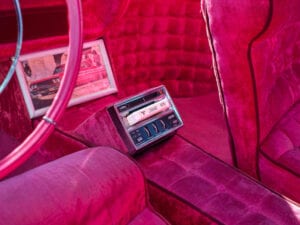From the first images of the great metropolis to portrayals of the Midwest, a new exhibition addresses architectural photography as a window on social and economic crisis and progression.
The first camera photograph was Nicéphore Niépce’s View from the Window at Le Gras, taken in 1826 or 1827 in Saint-Loup-de-Varennes, France. A crude and barely discernible black and white image that was taken in an exposure that lasted over the course of eight hours, it gives a view across the rooftops neighbouring his studio – structural elements being the only objects that would stay still long enough for such a lengthy exposure time.
Architecture and photography have continued to have a shared and mutually beneficial relationship, one which is being explored by the Barbican’s Constructing Worlds: Photography and Architecture in the Modern Age season, whose main exhibition houses some 250 works taken over the past 80 years by 18 photographers from every era and corner of the world: Berenice Abbott, Iwan Baan, Bernd and Hilla Becher, Hélène Binet, Walker Evans, Luigi Ghirri, Andreas Gursky, Lucien Hervé, Nadav Kander, Luisa Lambri, Simon Norfolk, Bas Princen, Ed Ruscha, Stephen Shore, Julius Shulman, Thomas Struth, Hiroshi Sugimoto and Guy Tillim.
The two creative practices have consistently run as primary strands of the Barbican Centre’s art programme, which has championed contemporary photography through recent showcases such as Everything Was Moving: Photography from the 60s and 70s (2012), In the Face of History: European Photographers in the 20th (2006) and previous shows American Images: Photography 1945-1980 (1984); William Eggleston: Ancient and Modern (1992). As curator, Alona Pardo recognises: “We’ve been leading the way since the 1980s with the first William Eggleston show in the UK, and Constructing Worlds was a perfect marriage of disciplines, bringing two distinct audiences together in one presentation to unpick and unravel some really critical issues which are still being played out today.”
Beginning with Berenice Abbott’s pioneering series, Changing New York (1935-1939), and progressing through to vernacular construction and documentary image-making via its progenitor Walker Evans, the display also looks at collaborations between architects and photographers such as that of Lucien Hervé and Le Corbusier, or Hélène Binet and Daniel Libeskind.
“Architects have always been aware of the power of an image to communicate architecture,”says Pardo. It is often through photography that we know about architecture; Chandigarh by Le Corbusier, for example, is best recognised through Hervé’s evocative representations of its geometric shape and form. Although the working relationship between Le Corbusier and Hervé was particularly close (Le Corbusier once telling the other “you have the soul of an architect”), it is not unusual. A photograph is able to communicate the shape and form of a building but also, through various techniques – the use of angles, colours and exposures – reveals how it makes its inhabitants feel.
Of course, skilled photography has always been utilised by architects in a commercial sense, and Constructing Worlds acknowledges this with copies of magazine spreads such as those by Julius Schulman. However, in addition to presenting Schulman’s colour images as printed in the glossy lifestyle press, the exhibition also shows his greyscale works, which have always been produced for the architectural press, with colour reserved for consumerism.
With this in mind, the entire first half of the show is devoid of colour: all pieces in this section present artistic and narrative methods for displaying structural landscapes. The display is not entirely organised in chronological order. However, it does begin with Abbott’s record of the urbanisation of New York, photographs which have typified the idea of a modern metropolis.
Thirty examples of Abbott’s 1,000-strong series are on show at the Barbican: precise constructions, the sharp angles of new skyscrapers contrasted with a mish-mash of low-rise buildings. Her series not only displays a great transformation, but also catalogues the lives of the New Yorkers in the midst of this change – site workers, bakers, families, the homeless – making her collection an ideal start to a show about the social experience of architecture.
It was critical to include Abbott, according to Pardo: “Institutionally, she is neglected as a photographer; other practitioners know her but it has been 20 years since she had a show here and even then, her works were shown in commercial spaces.” The curators had considered looking back even further than the 1930s, however, the question of relevance at this point in time became a factor. “Abbott’s work is still hugely significant and important in photography today, but pieces further back have had less of an influence upon contemporary projects. In the early days she not only made use of modern photographic strategies, but also in terms of her viewpoints she was a constructivist; she brought her own modernist language to her artworks.”
Pardo comments that “it is extremely clever to start the show with a female voice which is documenting a man’s world of macho skyscrapers.” As remains characteristic of the art world, female representation remains low. Of Constructing Worlds 18 photographers, three are women – the others being Lambri and Binet, who Pardo describes as “pure architecture photographers.”
In her dramatic, almost graphite-esque photographs, “Binet has a very atmospheric approach, it’s fragmented, beautiful; there’s never a sense of a whole building, but her works are like photo essays of the nooks and crannies of a whole building. She encapsulates the character of the structures.” Lambri, meanwhile, travels the world recording interior settings – particularly those of modernist buildings, but again, like Binet, often takes the approach of capturing viewpoints and architecture on a domestic, human scale.
These intimate portrayals of buildings are polar opposites to Gursky’s four-metre prints of estates and supermarkets, or perhaps Tillim, Kander and Norfolk’s desolate images. The last of these, Norfolk’s poignant Afghanistan: chronotopia and Scenes From a Liberated Baghdad series, is at first a somewhat surprising addition to an architectural photography exhibition.
Amongst Constructing Worlds angular images of modernist buildings and iconic photographs of the American midwest, as taken by Hervé or Shulman, are still depictions of “the lasting effects of war.” The unusual combination of what is commonly recognised as “architectural photography” and what might otherwise be seen as fine art, documentary, reportage or even portraiture was a key theme for Pardo and co-curator Elias Redstone who say they aimed to “collapse the established lines between styles, to break down the divisions, and collect them all in the same show and to see them just as photography.
“It didn’t matter to us whether the piece was artwork photography or seen as having a social purpose; it was important to have that discussion between artists.”
Norfolk’s work is included as Pardo “really wanted to explore the cultural ruin through the prism of conflict: how does violence affect our urban space, and how do we navigate through this?” He has been capturing images of various areas of Afghanistan for the past 20 years, as the curator comments: “There were always lots of photojournalists in Afghanistan with him, looking at the immediate moment of war, yet he was already interested in finding the legacy and the memorialisation of war (in destroyed buildings); when walking through these architectural monuments he saw that they told a very interesting story of the life history of Afghanistan.”
“For us, architectural photography is not just about accurate representation of a construction but instead the social and political context of a space. Buildings are silent witnesses: they’re the ones that are still there 100 years later, they have seen traumatic events and these moments are scarred on their surface in bullet wounds.” Norfolk makes photographs “in a very beautiful, poetic and painterly way, but his works are incredibly poignant.”
A similar tone is achieved in Kander’s work from China, which often recalls the casualties behind the commercialised surface of the country’s recent dramatic change, or Tillim’s exposé of decaying colonial structures in Angola, Congo, Madagascar and Mozambique – as Pardo affirms: “Whether it’s a military or economic crisis, this ruin of what’s left is very evident.”
An exhibition based solely around architectural photography could, Pardo admits, be “dry”, however, in including an international scope of widely varied practices, this is avoided. As described by the curators, “ultimately [architecture] is built by humans, and the human, social, economic, political context is where buildings come from,” and, additionally, “the photographer brings their own emotion to the way that this is depicted.” Therefore the show studies not the structure of spaces exactly, but social change via the medium of architecture in the 20th century, perhaps between two very different schools, with Abbott’s geometric constructions on the one hand, and contemporary photographers like Norfolk, Kander and Tillim on the other, who are inspired by Walker Evans, best known for documenting the Great Depression.
Evans’ interest in vernacular architecture influenced a generation of European and American image-makers during the 1960s and 1970s, creating a tradition of shooting buildings as a backdrop to the community that they supported and therefore recording both environment and social change. Having brought rise to the documentary approach and concentrating on his theme of depression, in contemporary photography “his legacy is still alive and well” – in style, but also in subject matter as ultimately our concerns today remain the same. As the curator notes: “the interests of the 1930s are still relevant, our recession is quite the same”, and in recent images of those left affected by economic change, we see the same expressions and stances repeated again, Kander’s series taken along the Yangtze a prime example.
From 2006 to 2008 Kander travelled 4,100 miles along the Yangtze’s banks from its mouth to its source – from the modernised city of Shanghai to the rural Qinghai province – and shot the country’s great economic diversity through crowded cityscapes, domestic scenes and barren landscapes, ruined by relentless urbanisation. In one image, Chongqing IV (Sunday Picnic) (2006), a family sit beside the riverside in woven wicker chairs at a table laid with a white tablecloth, a wooden boat drifts in and the image could be idyllic – however, the rubble at their feet and the enormous bridge overhead immediately make bleak this family scene. Constructing Worlds comprises both photographs in which architecture is an element to communicate social issues and those in which the constructed structure is the sole subject.
As Pardo explains, throughout the exhibition the subject matter remains our architectural landscape; however: “How we use spaces and what it means changes with new generations: there are new concerns, new issues, and this is what photographers capture.” This is also the reason that the two types of creatives work so closely with one another. Continuing the Barbican’s trend for reimagining its gallery spaces, Constructing Worlds has been designed by Kersten Geers and David Van Severen via internationally recognised Brussels architecture firm, Office KGDVS. The work is presented in an intervention which is based upon primary shapes – circles, squares, triangles and pentagons – all reflecting upon the geometrical forms which are displayed in the show.
The exhibition is part of a wider Constructing Worlds season, which presents a constellation of projects: a new commission in the Curve by the internationally acclaimed artist Walead Beshty; a film commission and residency by innovative architectural documentary makers Ile Bêka and Louise Lemoine; and a dedicated film strand named City Visions, which follows last year’s Urban Wandering season and focuses upon the fast pace of global city living. Constructing Worlds is a multi-layered assessment of social change as explored through the medium of architectural photography. Far from “dry”, the buildings it examines may indeed be “silent witnesses” but in these considered images, the stories that they tell speak volumes.
Constructing Worlds runs at Barbican Centre, London, from 25 September to 11 January. www.barbican.org.uk.
Chloe Hodge





